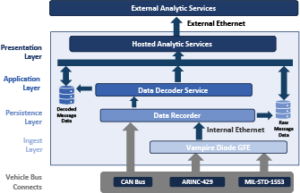
 Vibrant consists of a flight certified Mil-Spec hardware component that connects to the on-board data buses. Data bus connections are read-only, meaning that Vibrant can read but not write to the connected data buses. All bus data is recorded and decoded for real-time or post-mission analysis. The decoding is performed on-board for bus connected avionics LRUs. The bus connection is supported by a GFE solution known as Vampire that provides the read-only data connection. Vibrant incudes a 512-core NVIDIA Volta GPU, 64 Tensor Cores, and 8-core 64-bit ARM CPU and 4 TB of on-board storage to support several potential applications including on-board message decoding, real-time data analysis, critical information retrieval, and need-driven custom applications.
Vibrant consists of a flight certified Mil-Spec hardware component that connects to the on-board data buses. Data bus connections are read-only, meaning that Vibrant can read but not write to the connected data buses. All bus data is recorded and decoded for real-time or post-mission analysis. The decoding is performed on-board for bus connected avionics LRUs. The bus connection is supported by a GFE solution known as Vampire that provides the read-only data connection. Vibrant incudes a 512-core NVIDIA Volta GPU, 64 Tensor Cores, and 8-core 64-bit ARM CPU and 4 TB of on-board storage to support several potential applications including on-board message decoding, real-time data analysis, critical information retrieval, and need-driven custom applications.
Vibrant also includes a comprehensive set of tools in support of its data collection mission that include Controlled Access Cloud Accessible Data Storage and analytics to support various forms of analyses. These include post-mission contested environment testing, condition-based maintenance and logistics procedures, flight anomaly analysis and Intentional Unauthorized Electronic Interaction (IUEI) detection.
